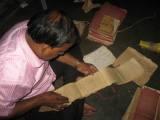Yatri Panji – The Database Mystery of Puri
 Inspired by the news of celebrities finding mention in the records of the Pandas in Puri, I wanted to verify what these records document and how the database has been maintained. The curiosity was after President Prativa Devi Singh Patil saw mention in the personal records called ‘Yatri Panji’ of the traditional Panda (People traditionally engaged in various services of Jagannath Temple) Damodar Mahasuara whose family has been looking after the pilgrims from the state of Maharastra and Gujarat. Not only the President Mrs. Patil, but her husband also did find mention of his ancestors in the records maintained by the Pandas of Puri.
Inspired by the news of celebrities finding mention in the records of the Pandas in Puri, I wanted to verify what these records document and how the database has been maintained. The curiosity was after President Prativa Devi Singh Patil saw mention in the personal records called ‘Yatri Panji’ of the traditional Panda (People traditionally engaged in various services of Jagannath Temple) Damodar Mahasuara whose family has been looking after the pilgrims from the state of Maharastra and Gujarat. Not only the President Mrs. Patil, but her husband also did find mention of his ancestors in the records maintained by the Pandas of Puri.
Former President Gyani Zail Singh and former Prime Minister Atal Bihari Vajpayee also were amazed to see the names of their forefathers in the database managed by the Pandas of Puri since time immemorial.
Called Yatri Panji or Yatri Bahi (visitors’ register), the records of devotees from across India and Nepal besides parts of Afghanistan and present Pakistan, form a huge database of Hindus living across the globe and, in most cases, tells the devotees their origin and ancestral history. These registers may not mean anything to us, but they are the most precious property of the Pandas of Puri who have stored these notebooks carefully in steel almirahs and boxes.
 ‘This process of recording the details about the devotees is still in practice. We are also following this. But neither we nor, even, the old priests have any idea of who started it and when. “Maybe the system of maintaining records started with the aim to keep the city of Puri secured and nuisance free,” says a young Panda Somanath Pratihari describing the system that regulated all the affairs of the devotees in the abode of Lord Jagannath.
‘This process of recording the details about the devotees is still in practice. We are also following this. But neither we nor, even, the old priests have any idea of who started it and when. “Maybe the system of maintaining records started with the aim to keep the city of Puri secured and nuisance free,” says a young Panda Somanath Pratihari describing the system that regulated all the affairs of the devotees in the abode of Lord Jagannath.
Earlier Puri was not a ‘free-for-all-visitors’ city as it is today. There existed a full-proof system to regulate inflow of devotees into the city and keep a watch on their activities. “In the past, the Pandas used to go to different parts of the country to propagate the cult of Lord Jagannath which, they believed, was a part of their services. They used to prepare the document of devotees interested to visit Puri for a darshan of Lord Jagannath. Then the devotees were to come in due process,” said Somanath.
The Panda had to hand over the document carrying the names and details of the devotees interested to visit Puri to a man designated as ‘Bata Gumasta’ who would bring the devotees to the outskirts of Puri. Then the devotees had to be looked after by the ‘Ghata Gumastas’ in charge of four Ghats – ‘Swargadwar’, ‘Atharanala’, ‘Mangala’ and ‘Balighat’. The visitors had to give details of their plans in Puri to the Ghata Gumasta who was supposed to manage their stay till darshan of Lord jagannath. As, during those times, a limited number of visitors were allowed for darshan a day, the Ghata Gumasta had to confirm the day of visit for the devotees and hand over an approved number of visitors to the ‘Dhulia Gumasta’ whose duty was to take the devotees till the temple. At the temple was ‘Deuli Gumasta’ who was in charge of taking the visitors inside the temple for the darshan. Each Panda had his own Gumastas to carry out the jobs at four stages. So, in the process, all the devotees who visited Puri for Jagannath Darshan were documented and finally the documents went to the Panda. The database kept being updated every year and went on expanding with records of devotees through generations.
The expanse of the database with the communities engaged in Jagannath temple services can be well-imagined from the limits the Pandas went through to venture out and propagate the Jagannath Cult and make a list of people interested to see their Lord in Puri. The database included visitors from Kabul, Kandahar, Nepal to Kanyakumari. The vast expanse of the landscape was divided into a number of territories putting one Panda or one family in charge of each territory. For example, one Panda looked after Punjab, Kabul and Kandahar; Nepal remained under one Panda; from Orissa’s Berhampur in Ganjam District to Kanyakumari – the southern part of India remained under one Panda. “Members of the community, i.e. the Pandas, used to start their journey to the respective territories after the rainy season and come back by Akshaya Trutiya to attend the first ritual of theLord’s famous Rath Yatra – the Car Festival,” said Madan Mohan Pratihari adding that, “The flow of devotees used to increase after the harvest season only and touch the peak during Rath Yatra and the database of the community recorded each and every visitor’.
Maintained since generations without any mechanized device, this unique database of the Pandas of Lord Jagannath Temple has not lost its relevance even today. “We have records since hundreds of years with data over ten to twelve generations of devotees. People from distant places come to us, meaning their respective Panda, to get the ancestral tree up to three or seven generations to perform the Shradh – a Hindu ritual meant to pay tribute to the souls of the predecessors,” said Batakrustna Pratihari – a member of the family that has been looking after devotees from Southern Indian states traditionally.
There are many other stories based upon this database. To cite an interesting one dating back to the British days in India, Somanath Pratihari said, “The records of a Panda even helped one to get his share of parental property by proving his legitimacy as an heir. The man – a son of the second wife of his father was denied of any share on the grounds that his mother was not married to the father. The son, while visiting Puri, found the name of his mother mentioned as the wife of his father with his father’s signature below. The man went and placed the data in Patna High Court and got his share.” Somanath has heard of the story from old members and his forefathers who were alive when the incident occurred.
To Madhusudan Khuntia, it is disappointing that, “The huge database of Hindus living across the globe is now facing the danger of becoming stale as its updating scope is getting limited day by day. With facilities of communication and hotels, the city has become easily accessible to everyone and visitors stay in hotels and go back after the darshan. Many do not look for their Panda anymore.”
For fun and to satisfy your devotional urge, Puri has many things in and around. But, still, if you want to prepare a family tree or are keen to know where you originated from, here in Puri is something that would make you believe that the cult surrounding the temple of Lord Jagannath has many more mysteries to be explored.


